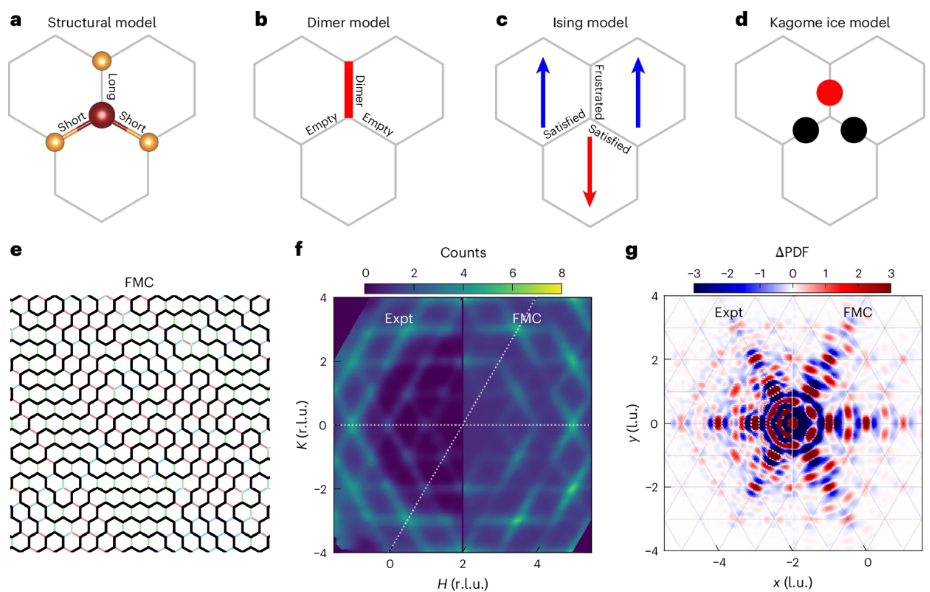In most crystals, atoms line up in neat, repeating patterns where every bond and every magnetic moment fall into place. The structure is stable, the magnetism is ordered, and the system rests in balance. But researchers studying a new family of materials called LnCd₃P₃ found something very different. Inside this material, some bonds between atoms become slightly shorter or longer than others, and the triangular geometry of the lattice prevents them from forming an orderly pattern. This creates what scientists call bond-order frustration, where the bonds are constantly competing, unable to agree on a single stable arrangement.
Even more intriguing, this material also contains magnetic frustration, a phenomenon where the atomic magnets (spins) of the crystal lattice can’t all align the way they prefer. The discovery reveals a rare case where both magnetic and structural frustration coexist and interact in the same lattice.
In a new study published in Nature Materials, researchers explored these intertwined frustrations using advanced X-ray techniques at the QM2 beamline at CHESS. The beamline is funded by the U.S. National Science Foundation and led by CHESS staff scientist Suchismita Sarker, a co-author on the paper. Experiments at QM2 provided a detailed picture of how atomic bonds and magnetic moments compete and coexist within this unique quantum playground.
Why it matters
Frustrated materials are a playground for discovering new physics. Because their atomic arrangements are delicately balanced, even small changes like adding charge carriers, applying pressure, or tweaking temperature, can tip the system into an entirely new state. When both structural and magnetic frustrations coexist, as in LnCd₃P₃, the possibilities multiply.
These materials could help researchers explore how magnetism and atomic structure influence one another at the quantum level, potentially leading to new types of quantum phase transitions, unconventional superconductivity, quantum criticality or materials that can switch their electronic or magnetic properties in response to external forces. Understanding and controlling these intertwined instabilities could open pathways to designing new classes of adaptive or “responsive” quantum materials.

Why CHESS was needed
To reveal how atomic frustrations develop in real space and to uncover short-range structural correlations that traditional crystallography cannot detect, researchers utilized the synchrotron X-ray at QM2 beamline, CHESS, which is specifically designed for high-precision single-crystal studies. By leveraging QM2’s advanced features—such as high-energy X-ray flux, cryogenic temperature control, a large detector to capture weak diffuse signals, and scalable data processing—the team performed Three-Dimensional-Δ Pair Distribution Function (3D-ΔPDF) analysis. This analysis allowed them to map the subtle shifts and reorganizations of the Cd–P bonds within the crystal lattice. The data revealed short, chain-like distortions, which are evidence of bond-order frustration that coexist with a frustrated magnetic network. CHESS provided the necessary brightness and stability to measure these weak scattering features, enabling researchers to connect atomic-scale disorder to the material’s broader magnetic and electronic behaviors. This research offers a deeper insight into how structural and magnetic frustrations intertwine, insights that would not have been possible without synchrotron-based X-ray techniques.
Looking ahead
The discovery of intertwined bond and magnetic frustration in LnCd₃P₃ highlights how geometry alone can destabilize even the most orderly crystal, pushing it toward new and unpredictable behaviors. By revealing how these competing forces coexist at the atomic scale, researchers now have a blueprint for studying how structure and magnetism influence one another in quantum materials.
The work also underscores the power of synchrotron X-rays to capture the hidden order that lies between crystalline perfection and complete disorder. As researchers continue to tune and dope this new class of materials, they hope to uncover whether this delicate balance can give rise to entirely new electronic or magnetic phases.
Meet the Researchers:
S. J. Gomez Alvarado
Materials Department, University of California, Santa Barbara, Santa Barbara, CA, USA
J. R. Chamorro
Materials Department, University of California, Santa Barbara, Santa Barbara, CA, USA
D. Rout
Materials Department, University of California, Santa Barbara, Santa Barbara, CA, USA
J. Hielscher
Department of Physics, Technical University of Munich, TUM School of Natural Sciences, Munich, Germany
Sarah Schwarz
Materials Department, University of California, Santa Barbara, Santa Barbara, CA, USA
Caeli Benyacko
Materials Department, University of California, Santa Barbara, Santa Barbara, CA, USA
M. B. Stone
Neutron Scattering Division, Oak Ridge National Laboratory, Oak Ridge, TN, USA
V. Ovidiu Garlea
Neutron Scattering Division, Oak Ridge National Laboratory, Oak Ridge, TN, USA
A. R. Jackson
Materials Department, University of California, Santa Barbara, Santa Barbara, CA, USA
G. Pokharel
Materials Department, University of California, Santa Barbara, Santa Barbara, CA, USA
R. Gomez
Materials Department, University of California, Santa Barbara, Santa Barbara, CA, USA
B. R. Ortiz
Materials Department, University of California, Santa Barbara, Santa Barbara, CA, USA, Neutron Scattering Division, Oak Ridge National Laboratory, Oak Ridge, TN, USA
Materials Science and Technology Division, Oak Ridge National Laboratory, Oak Ridge, TN, USA
Suchismita Sarker
Cornell High Energy Synchrotron Source, Cornell University, Ithaca, NY, USA
L. Kautzsch
Materials Department, University of California, Santa Barbara, Santa Barbara, CA, USA
L. C. Gallington
X-ray Science Division, Advanced Photon Source, Argonne National Laboratory, Argonne, IL, USA
R. Seshadri
Materials Department, University of California, Santa Barbara, Santa Barbara, CA, USA
Materials Research Laboratory, University of California, Santa Barbara, Santa Barbara, CA, USA
Stephen D. Wilson
Materials Department, University of California, Santa Barbara, Santa Barbara, CA, USA
